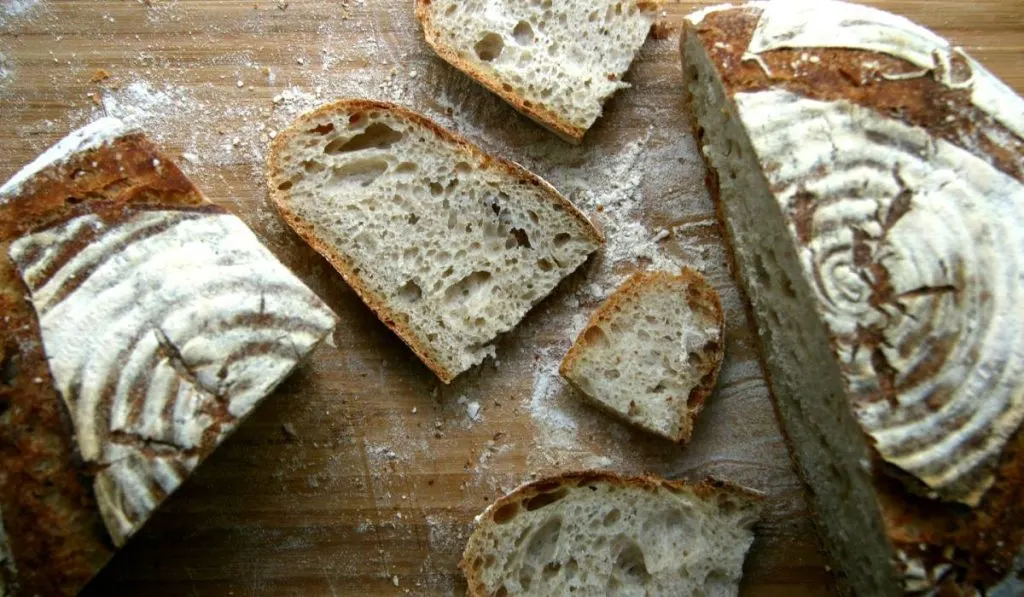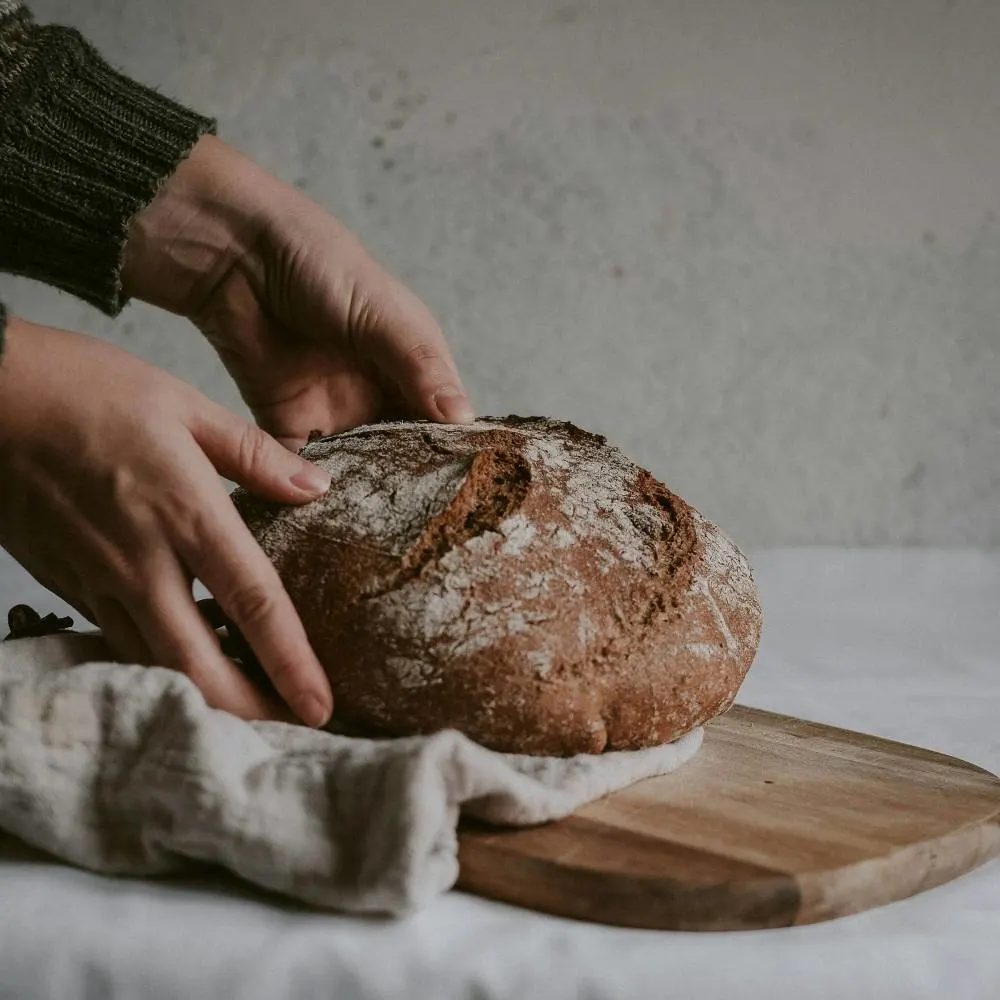
Sourdough bread isn’t just a food trend; it’s a flavorful, traditional bread that comes with a unique twist — probiotics. Have you ever wondered why sourdough tastes so different, so… alive? The answer lies in the healthy microbes that give this bread its unique flavor and texture.
But, why does that matter? In a world obsessed with probiotics — yogurt, kombucha, kimchi — you might be missing the easiest way to add beneficial bacteria to your diet: Probiotic Sourdough Bread. From gut health to better nutrient absorption, this bread is changing the way we think about probiotics.
TL;DR
- Probiotic Sourdough Bread offers digestive benefits thanks to its natural probiotics.
- This bread has a rich flavor and a delightful chewy texture due to a fermentation process involving wild yeast and lactic acid bacteria.
- Probiotic sourdough is easier to digest than conventional bread and offers better nutrient absorption.
- Making sourdough at home is not just fun, but also highly rewarding for your taste buds and your health.
- It’s a delicious, flavorful alternative to regular bread with plenty of health benefits!
What Makes Sourdough Bread “Probiotic”?
Most bread types you buy at the grocery store involve commercial yeast, a quick process that sacrifices flavor and, more importantly, probiotics. Sourdough, on the other hand, is fermented using wild yeast and lactic acid bacteria, which break down the flour over time. This slower fermentation creates a bread that is not just flavorful but also naturally probiotic.
Probiotics: The Gut’s Best Friend
Probiotics are the good bacteria that support a healthy gut microbiome. They play a crucial role in digestion, immunity, and even mental health. When you eat sourdough bread, you’re introducing these friendly bacteria into your system. This sets sourdough apart from standard bread, which lacks these gut-boosting microbes.
Why Choose Probiotic Sourdough Bread Over Regular Bread?
Choosing probiotic sourdough isn’t just about health; it’s about flavor, digestibility, and tradition. Let’s explore some of the benefits that make it a standout choice.
1. Easier on Digestion
One of the most compelling reasons to switch to sourdough is its easier digestibility. The fermentation process breaks down gluten and phytic acid, which makes the bread more digestible and easier on the stomach. Even those with mild gluten sensitivities find sourdough easier to tolerate than regular bread.
2. Nutrient-Rich & Health-Boosting
The lactic acid bacteria in sourdough increase the bioavailability of nutrients in the flour. This means you’re not just getting the nutrients; your body can actually absorb them. Sourdough is packed with B vitamins, minerals like zinc and magnesium, and antioxidants — all while being low in sugar and fat. So, you get a nutrient-dense food that supports overall health, including your gut and immune system.
3. Flavor Explosion: A Bread Lover’s Dream
Probiotic sourdough is a bread connoisseur’s dream. It has a tangy flavor, chewy texture, and crisp crust that beats store-bought bread any day. The depth of flavor comes from the long fermentation, which brings out the natural flavors of the flour and develops that signature sourdough taste. Trust me, once you try a warm, freshly baked slice with a bit of butter, there’s no going back!
Making Probiotic Sourdough Bread at Home: Worth the Effort?
Is it worth making sourdough bread at home? Absolutely! Crafting your own sourdough gives you control over the ingredients and the fermentation process, ensuring you’re reaping the full probiotic benefits. While it may seem intimidating at first, the process is straightforward and rewarding.
The Secret to a Great Starter
The heart of any sourdough is the starter — a mixture of flour and water left to ferment naturally with wild yeast and bacteria. Creating a good starter takes patience, but it’s the key to making bread that’s full of probiotics. Feed it regularly, keep it warm, and in a few days, you’ll have a bubbly, active starter ready to create probiotic-rich bread.
Tips for the Perfect Loaf
- Use Whole Grain Flour: Whole grains are more nutrient-rich and add depth to the flavor.
- Ferment Slowly: A longer fermentation leads to more probiotics and richer flavor.
- Experiment with Hydration: Wetter doughs (more water) produce an open crumb structure, while drier doughs make a denser loaf.
Remember, every loaf you bake will be unique, and that’s the beauty of making sourdough at home. Whether it’s your first loaf or your fiftieth, each one tells its own story through flavor, texture, and crust.
Common Myths About Probiotic Sourdough Bread
Myth #1: All Sourdough Bread Is Probiotic
Not quite! Commercial sourdough bread often uses additives and shortcuts that destroy the probiotic content. To ensure you’re getting all the benefits, look for “wild” or “naturally leavened” sourdough bread, or bake it yourself.
Myth #2: Sourdough Bread Is Gluten-Free
Although the fermentation process breaks down much of the gluten, sourdough is not gluten-free. However, it is lower in gluten than conventional bread and often better tolerated by those with mild sensitivities.

Probiotic Sourdough Bread in Your Daily Diet
Incorporating probiotic sourdough into your meals is easier (and tastier!) than you might think. Not only does it bring that distinct tangy flavor, but it’s also versatile enough to elevate any meal. Let’s look at some simple yet delicious ways to make probiotic sourdough part of your daily routine:
1. Breakfast Toast: Start Your Day Right
Kick off your morning with a slice of sourdough that pairs perfectly with a variety of toppings. Here are a few ideas:
- Avocado & Egg Toast: Mash ripe avocado on toasted sourdough, sprinkle with a pinch of salt, pepper, chili flakes, and top with a poached or fried egg. Add a drizzle of olive oil for extra flavor and healthy fats.
- Smoked Salmon & Cream Cheese: Spread a layer of cream cheese, add thin slices of smoked salmon, and finish with a touch of lemon juice and fresh dill for a refreshing, protein-packed start to your day.
- Nut Butter & Berries: Craving something sweet? Try almond or peanut butter spread generously on sourdough, topped with fresh berries, bananas, or even a sprinkle of cinnamon. It’s an energy-boosting, nutrient-dense breakfast option.
2. Lunch Sandwiches: A Tangy, Satisfying Meal
Probiotic sourdough is a fantastic choice for sandwiches, whether you’re at home or on the go. The chewy texture and robust flavor of the bread make even the simplest sandwiches feel gourmet.
- Gourmet Grilled Cheese: Elevate your grilled cheese game by adding thinly sliced tomatoes, fresh basil, or caramelized onions. The sourdough’s crunchy crust complements the gooey, melted cheese inside, making it a comforting, satisfying meal.
- Classic BLT with a Twist: Use sourdough slices for a BLT (bacon, lettuce, and tomato) and add avocado or a smear of pesto for an extra layer of flavor. The tanginess of the bread brings out the saltiness of the bacon and freshness of the veggies.
- Turkey & Cranberry Delight: For a twist on traditional deli sandwiches, layer turkey slices, cranberry sauce, and arugula on sourdough. The sweetness of the cranberry pairs beautifully with the tang of the bread, making each bite flavorful and balanced.
3. Dinner Sides: The Perfect Companion
Probiotic sourdough bread isn’t just for breakfast and lunch; it makes a fantastic dinner side that pairs well with a range of dishes.
- Soups & Stews: Serve sourdough with a bowl of hearty soup, such as tomato basil, lentil, or creamy potato leek. The bread’s robust structure makes it ideal for dipping, soaking up all the savory flavors without getting soggy.
- Pasta Night Upgrade: Ditch the garlic bread for toasted sourdough slices brushed with olive oil, garlic, and fresh herbs. It’s a great way to add a probiotic punch to your pasta night, providing a satisfying crunch alongside creamy Alfredo or zesty marinara.
- Salad Booster: Serve sourdough slices alongside a fresh salad, like a Greek salad or Caesar. Tear it into crouton-sized chunks and toast them with a bit of olive oil for homemade croutons that add a delicious tang and crunch to any bowl of greens.
4. Quick Snacks & Appetizers: A Bite of Flavor
Sourdough doesn’t have to be reserved for main meals; it makes a great base for snacks and appetizers too.
- Bruschetta Delight: Top toasted sourdough with diced tomatoes, basil, garlic, and balsamic glaze for a classic Italian appetizer that’s quick and delicious. The bread’s tanginess pairs perfectly with the acidity of the tomatoes.
- Cheese & Charcuterie Board: Slices of sourdough make a wonderful addition to any cheese or charcuterie board. Pair with soft cheeses like brie or goat cheese, hard cheeses like parmesan, or cured meats like prosciutto or salami. Add olives, nuts, and honey for a complete flavor experience.
- Garlic & Herb Sourdough Chips: Slice sourdough thinly, brush with olive oil, garlic, and your favorite herbs, then bake until crispy. These make great snacks on their own or pair beautifully with dips like hummus, spinach-artichoke dip, or salsa.
5. Sourdough for Dessert? Yes, Please!
While it might sound unconventional, sourdough can be the perfect canvas for sweet treats.
- French Toast Upgrade: Use slightly stale sourdough for an amazing French toast. Dip the slices in a mixture of eggs, milk, cinnamon, and vanilla, then cook until golden brown. Serve with maple syrup, fresh berries, or even a dollop of whipped cream.
- Bread Pudding: Turn leftover sourdough into a delicious bread pudding. Tear the bread into chunks, soak in a mixture of milk, eggs, sugar, and spices, then bake until golden and custardy. A warm, spiced sourdough bread pudding makes a cozy dessert for any season.
- Chocolate & Nut Spread Toast: Spread some hazelnut-chocolate spread (like Nutella) over a toasted slice of sourdough, and top with chopped nuts, shredded coconut, or banana slices for an indulgent yet simple dessert.
Bonus Tip: Store it Right!
Keep your sourdough in a paper bag, cloth bread bag, or bread box to maintain its crust and texture. Avoid plastic, which can make the bread soggy.
Conclusion: Probiotic Sourdough Bread — Your Gut Will Thank You!
From its tangy taste to its gut-boosting benefits, probiotic sourdough bread is more than just a food trend; it’s a lifestyle choice that combines tradition, flavor, and health. Whether you’re a seasoned baker or just getting started, there’s a place for sourdough in your diet.
If you’ve been wondering whether sourdough bread is worth the hype — it is. It’s time to put down the supermarket sandwich bread and embrace the magic of probiotic sourdough. Your taste buds, and your gut, will thank you!
FAQs
What makes sourdough bread probiotic?
The wild yeast and lactic acid bacteria used in the fermentation process of sourdough bread create probiotics, making it a gut-healthy choice.
Is all sourdough bread probiotic?
No, not all sourdough bread is probiotic. Only naturally leavened sourdough bread made with a traditional fermentation process contains probiotics.
Can people with gluten sensitivity eat sourdough?
People with mild gluten sensitivities often find sourdough easier to digest than regular bread due to the fermentation process breaking down some of the gluten.
How should I store sourdough bread?
Sourdough bread should be stored in a paper bag, cloth bread bag, or bread box to maintain its texture and flavor. Avoid plastic bags to prevent it from becoming soggy.
Does sourdough bread taste sour?
The taste of sourdough varies depending on the fermentation time and the type of flour used. It often has a tangy flavor but can range from mild to very sour.
Is it easy to make probiotic sourdough bread at home?
Yes, while it requires some patience and practice, making probiotic sourdough bread at home is manageable and rewarding. The key is developing a healthy starter.
Are the probiotics in sourdough bread still active after baking?
Some probiotics may not survive the baking process, but the prebiotic fiber and other health benefits remain.
Can sourdough help with gut health?
Yes, sourdough contains beneficial probiotics and prebiotics that can support gut health and improve digestion.
How does sourdough bread compare to regular bread nutritionally?
Sourdough is often more nutrient-dense, with higher levels of vitamins, minerals, and antioxidants, and is generally easier to digest than regular bread.
Can I freeze sourdough bread?
Yes, sourdough bread freezes well. Slice it before freezing for easy portion control and thaw as needed.
Join Us and Transform >
Don’t Be an Amateur! Master the Art of Sourdough Bread!




Leave a comment